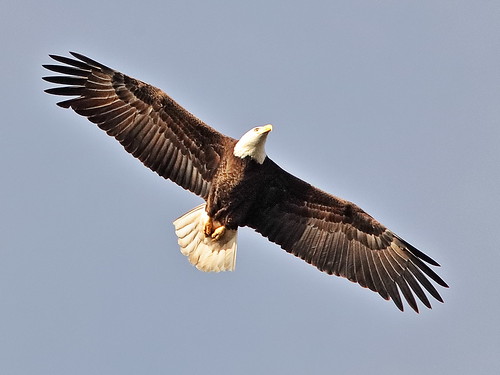
First one, and then a flock of Tree Swallows joined her. They did not attack or disturb her, but just floated around in circles with her:
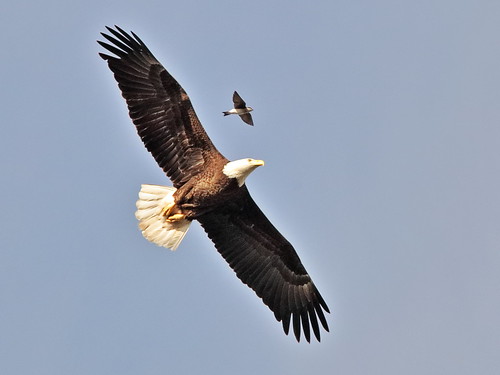
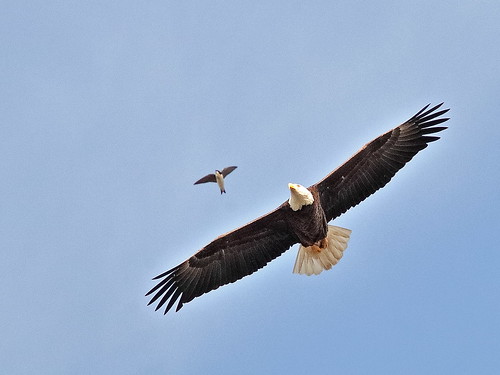

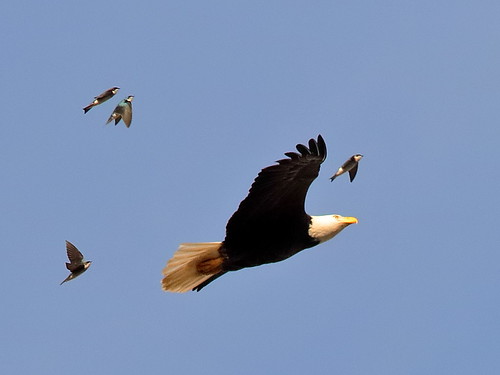
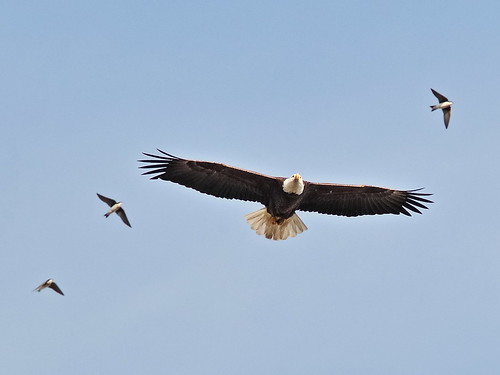
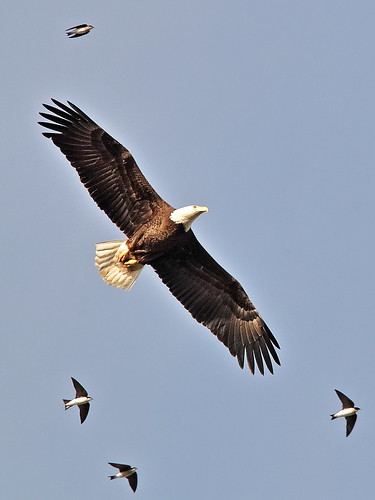
One may ponder the reason for this behavior. The swallows are migrants from the north and they have no territory to defend. Did the swallows perceive a threat? If so, there was no sign of this, as they glided effortlessly with the large bird and rotated together, gaining altitude before departing. Perhaps heat from the pavement of the roadway created a local updraft, and all simply took advantage of it. For me, the uplifting beauty of nature was a sight to behold and enjoy.
A Turkey Vulture also rode on the rising currents. Its wingspan is about 6 feet, about a foot less than that of the female eagle. Its tail is long but its neck is short. From a distance it may almost appears headless. Its silvery flight feathers contrast with the darker leading edge of the wing:
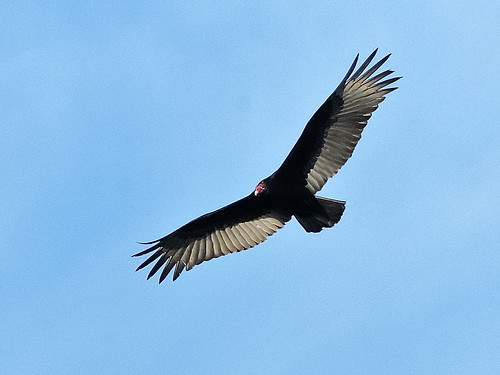
Flocks of Black Vultures were also present. Smaller than Turkey Vultures, they look "front-heavy" with short tails and they extend their necks in flight.

Black Vultures have whitish wingtips and relatively shorter wings (4.5 to 5.5 feet) and must flap often and strongly to gain altitude:
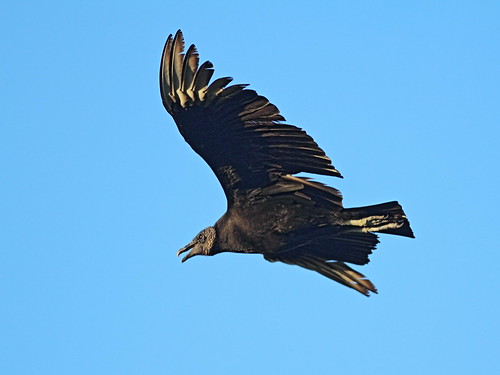
Sometimes an immature Bald Eagle may join a flock of vultures. Turkey Vultures have an exceptionally keen sense of smell. Until the eagle becomes fully competent as a hunter, it will often feed on carrion. A meal of roadkill may be its last, as many are struck by motor vehicles. This is a juvenile (first year) bird, as evidenced by its dark bill and bulging secondary wing feathers. Its head and tail will turn almost completely white when it is about four years old:
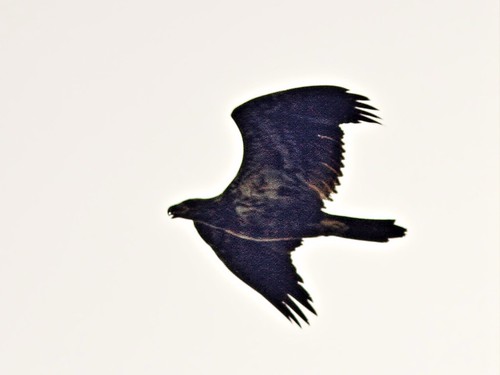
A few times I have identified a Short-tailed Hawk flying with vultures. The association may allow the hawk to escape detection before it drops like a stone to catch an unwary bird:
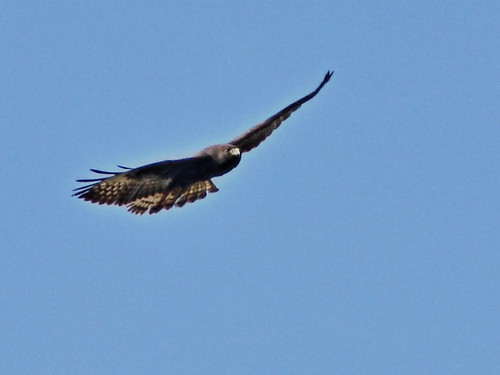

Fish Crows often loaf in the vicinity of the eagle nest, which if left unguarded may provide a meal of leftover prey, or worse, an egg or nestling. They can be distinguished from hawks and vultures by the fact that they almost never soar, beating their wings constantly as if "rowing a boat:"


We have enjoyed deliciously cool and clear mornings out on our local wetlands. Still air sets up beautiful reflections. From our shadowed vantage point on the lakeside marsh, we watch as the sun, rising in a cloudless sky, touches the pine bank on the opposite shore:
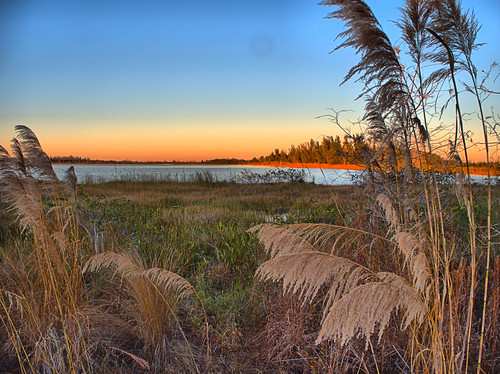
Mottled Ducks bask in full morning light:
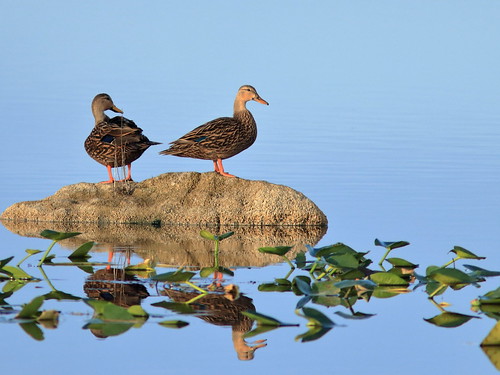
= = = = = = = = = = = = = = =
Linking to Misty's CAMERA CRITTERS,
Linking to Eileen's SATURDAY'S CRITTERS,
Linking to SKYWATCH FRIDAY by Yogi, Sylvia and Sandy
Linking to WEEKEND REFLECTIONS by James
Linking to BirdD'Pot by Anni
Linking to Our World Tuesday by Lady Fi
Linking to Wild Bird Wednesday by Stewart
Linking to Wordless Wednesday (on Tuesday) by NC Sue
Linking to ALL SEASONS by Jesh
________________________________________________
Please visit the links to all these memes to see some excellent photos on display
________________________________________________
All those flight images are so good and interesting just why the small birds were flying round the Eagle. That is a superb reflection shot Kenneth.
ReplyDeleteI was hoping for a passing eagle too, but had to do with a splatter of vultures.
ReplyDeleteGeorgeous!!
ReplyDeleteMagnificent birds in flight.
ReplyDeleteFabulous shots!
ReplyDeleteReally a pleasure to view them.
Great shots! Especially the first 7 images are very impressive.
ReplyDeleteNever seen anything like that. And what a lovely captures too. Superb.
ReplyDeleteBeautiful photography and really interesting behavior. Kind of reminds me of a remora following a shark, although that behavior is easy to explain.
ReplyDeleteThe Tree Swallows know that the Eagle can read the thermals to soar on the wind so perhaps they just accompany her as a guide. Lovely photos of these birds in flight.
ReplyDeleteTruly amazing photos!
ReplyDeleteI learned a lot from your post, Kenneth. We have black vultures, we mostly see them soaring or else gathering in the roadside ditches. We also have bald eagles either soaring or perched high in a tree. Other birds around our lake, North of Houston, are water turkeys (black), egrets, cranes, and ducks.
ReplyDelete..
Stunning shots and magnificent birds
ReplyDeleteOutstanding series of flight shots, always the most difficult to attain. The interplay between the swallows and the eagles is quite captivating. Any day with a Bald Eagle is a good day!
ReplyDeleteHello, Ken! WOW! Awesome captures of the eagles with the swallows. The photos are just amazing. I saw a lot of vultures in Florida. The last shot is beautiful too. Thank you so much for linking up and sharing your post. Happy Saturday, enjoy your day and weekend. PS, I appreciate and thank you for your comment on my blog.
ReplyDeleteYour wetlands look quite different than ours this month! We're at -24 C. this a.m.
ReplyDelete(ツ) from Cottage Country Ontario , ON, Canada!
stunning eagle shots
ReplyDeleteIncredible narration today! I enjoyed it all along with beautiful photos.
ReplyDeleteHere's hoping for you a beautiful week ahead, and good birding ...thanking you for letting us experience your blog post linked at I'd Rather B Birdin'.
yours birds in flight are magnificent - I love watching birds soar!
ReplyDeleteHow interesting about the tree swallows. We saw hundreds of them over a wet area at a preserve this week and they sure are hard to photograph! lol I took a video and that was fun. Enjoy your day!
ReplyDeleteIt's a joy to see your photos. Today I got to imagine soaring with the eagles, vultures, and swallows. Amazing. Thank you.
ReplyDeleteLovely images! I'm surprised the other birds aren't afraid of being so close to the eagle.
ReplyDeleteThanks for sharing at http://image-in-ing.blogspot.com/2019/01/morning-glory.html
There's lots of eagles in the trees around our place right now. - Margy
ReplyDeleteI love the shots of the eagle with the Tree Swallows - what a contrast!
ReplyDeleteCheers - Stewart M - Melbourne
PS: sorry for slow reply, I have been away.
So interesting, Ken! From your images I can see the black vultures' wings are definitely shorter and have a different shape that the Turkey vulture.
ReplyDeleteAbout your comment: hope you remember to give us a capture of the flowering mango! I don't think I've ever seen the flowers! Have a fantastic week!
Don't know if my comment got through, so I'm giving it again. So interesting! From your (stunning) images I can see the wings of the black vulture are definitely shorter, and they also have a rounder shape at the back side!
ReplyDeleteAbout your comment: hope you give us at All Seasons a capture of the flowers of the mango - I don't think I've ever seen them:)
Love your ducks! The raptors flying together are fascinating. We have black vultures and from a distance, they look graceful as they soar on the air currents.
ReplyDelete